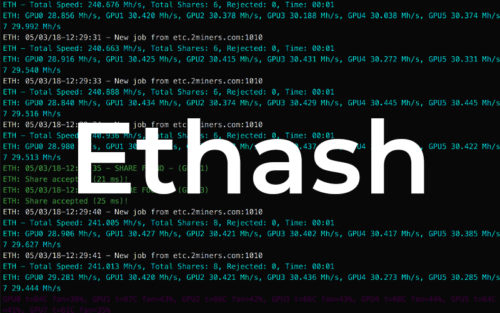Isn’t it crazy how cryptocurrencies have only been around for about a decade yet we have hundreds of cryptocurrency terminologies? Being a crypto-enthusiast myself, I know how difficult it can be to keep up with all the new terminologies. So maybe you have come across this term before and you would like to understand it further. Come with me as I explain Ethash to the best of my ability.
So what is Ethash algorithm?
Ethash is a proof-of-work (PoW) mining algorithm that is implemented by the Ethereum network and other Ethereum-based cryptocurrencies. Each Ethash GPU miner requires 1+ GB of RAM.
Proof of work mining secures distributed networks and processes blocks of transactions on the blockchain. It involves taking data from a block and then repeatedly hashing that data using a cryptographic hashing algorithm. The result is an output of fixed length that represents the hash value. Miners end up with several variations of the data input. So in the case of Ethereum, the algorithm used for this process is Ethash.
Ethash was developed as an upgrade of its predecessor called Dagger-Hashimoto to remove computational overhead.
The Ethash algorithm is used to dynamically adjust the mining difficulty of the blockchain that implements it. It does this by determining roughly how much computational resources should be spent for a miner to find the nonce that allows them to propose a new block to add to the blockchain. This algorithm follows a route in which a seed can be computed for each block by scanning through the block headers. This route can compute a 16 MB pseudocode cache which is then stored by light clients. Eventually, the cache is generated into a 1 GB dataset and stored by miners and full clients. The dataset progresses linearly over time while being verified until it is updated. Large datasets are updated once every 30,000 blocks.
The details of an Ethash cache and datasets are determined by the block number, which is that the cache and dataset sizes grow linearly.
ASIC miner controversy
Ethash was designed to be ASIC-resistant and efficiently verifiable by a light client. What that means, is that Ethash was developed with a strong focus on the protection from ASIC miners. ASIC stands for Application-Specific Integrated Circuits. Unfortunately, the outstanding popularity of Ethereum led to an increased interest of ASIC developers in manufacturing Ethash compatible miners.
In 2018 the first ASIC Ethash miners for Ethash (the ASIC-resistant) were announced by Bitmain. However, the Ethereum project community opposed this move strongly, due to fear of over-influence from Bitmain. As a result, discussions to brick the devices force ASUC miners into hard-mode mining, or to expedite the development and eventual release of Casper. Such inconsiderate proposals finally made ASIC miners conceal their presence and lower the cashing power of their devices. Lastly, the Ethereum plan to switch from Proof-of-work to proof-of-stake hybrid makes ASIC Ethash development a very risky investment.
Even though Vitalik Buterin, the co-founder of Ethereum does not consider ASIC miners to be a threat to Ethereum, there are plans to change the operation mode very soon. On a future hard fork yet to be released, ETH will produce all new blocks with a PoS through a separate design of Casper called Casper the Friendly GHOST or Casper Correct-By-construction.
In a nutshell, Ethash has been made ASIC-resistant to make the mining process open. And the implementation of a Proof-of-Stake structure will make the Ethereum mining obsolete.
Ethash Mining
Ethash mining can be conducted using the CPU and the GPU. Note that Ethash-based cryptocurrencies differ in their demands on the mining. Below is an illustration of Ethereum, being the most popular of Ethash implementations. The first thing you need to be able to start mining ETH is a fully synched cryptocurrency client that is enabled for mining and at least one ETH account. You could also need a wallet or an account in a specific network depending on the cryptocurrency.
CPU mining
This option is no longer profitable because GPU mining is two times more efficient. However, it is still good for first-time mining attempts or when you intend to mine a small number of coins to power smart contracts. Ethereum CPU mining is performed with an Ethereum client called geth which is a program that connects the ETH network with the gear of the miner. The coins which are mined are sent directly to the miners’ Coinbase address within a network.
GPU mining
This happens to be the best possible option for Ethash, Ethash being memory-hard and needing at least 1-2 GB of RAM on each GPU used. There are two types of GPU mining which are AMD GPUs and NVidia GPUs. To start GPU mining, you first need to download Ethminer which is an Ethash miner suitable for every Ethash-based crypto. There are several forms of Ethminer available e.g. CLI, GUI, and Ethminer.
Pool mining
This is another available option, and it is applicable for most Ethash cryptocurrencies. Pools often require miners to pay some fees around 1% – 2% of the income. It is the best mining option when you have mediocre gear.
Ethash Coins
The most popular Ethash-based Blockchain is the Ethereum network. Ethash was developed by the Ethereum foundation purposely to build its network. The very first blockchain was forked after the Dao was hacked due to its smart contract-related vulnerability. This split the project up in two different blockchains with their cryptocurrencies, Ethereum (ETH) and Ethereum Classic (ETC). Ethereum classic is no longer under the development of the original Ethereum team.
ETH is the main platform for creating tokens and decentralized-applications with their cryptocurrencies.
Here are some of the independent cryptocurrencies with their Ethash-based blockchain with minable crypto according to CoinGuides.
- Metaverse (ETP)
- Expanse (EXP)
- Musicoin (MUSIC)
- Ellaism (ELLA)
Ethash mining calculator
A mining profitability calculator helps you to find the cryptocurrency versus traditional currency e.g. the USD return depending on your hash rate, electricity cost, and power consumption. You can know just how profitable the mining of specific cryptocurrencies is. In very few steps you can understand the potential earnings of your hardware. A good profitability mining calculator has either a GPU coin or ASIC coin miner.
I understand that as a new trader you may find it difficult to know which calculator is the best for you. I mean when you search for ‘best profitability calculator’ on google, you are going to end up with tens or even hundreds of options. My recommendation would be Minerstat, which is a crypto mining monitoring and management platform for ASICs, GPUs as well as FPGAs. The Minerstat calculator has a very friendly user interface, you enter your power consumption details, your currency version, your hash rate, and electricity cost and just like that you can know your reward calculation which is computed within less than a second.
Just don’t forget that results from the mining calculator are and estimation strongly based on the current difficulty, block reward and exchange rate for the particular coin of interest. Therefore, ensure that you conduct enough research before invest because errors do occur and your investment decisions should never be based solely on the results of a profitability calculator.
How do you mine Ethash?
Mining ethash is a pretty simple process. And even can you do it with your own computer. First of all, there are to ways that you can do it.
The first would be to mine Ethereum (ETH) only, which can be mined with your GPU:
Step 1 – Make sure your GPU has its drivers up to date
Step 2 – Get an Ethereum (ETH) wallet ( Metamask recommended)
Step 3 – Join an Ethereum mining pool and start mining
From here, you need to check that your wallet address is correct and see how much you mine daily. Usually, with a good GPU, you can earn between $2 and $6 per day in revenue.
But if you wanna mine more than Ethereum, there are certain miners that can help you mine easily with a software. The process is fairly easy and we’ll present it below
Step 1 – Do a bit of research about the best miners out there. ( You can check out more in our article here)
Step 2 – Install the required software and configure it with your digital address ( Attention: some miners would pay you in BTC which you can convert afterwards in ETH or other cryptocurrency that you want. Make sure you put up a correct address )
Step 3 – You’re all set! Now you can check what is your mining power, your profit per day and test alternatives to find the best paying one. Also, make sure your GPU doesn’t overheat
Support Zerocrypted
- Trade on Bitmex
- Trade on Binance Jersey
Subscribe to our Newsletter to be a part of our future $1,000 per month contests.


